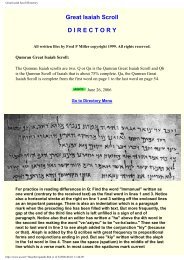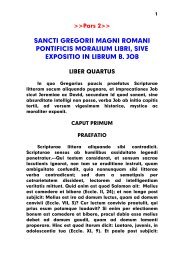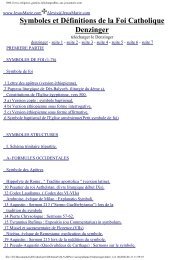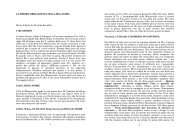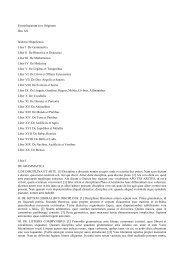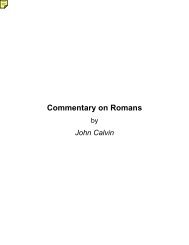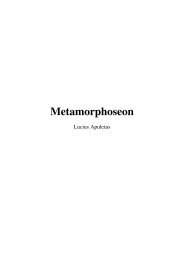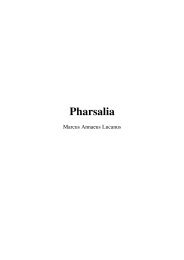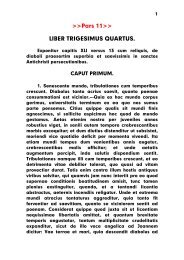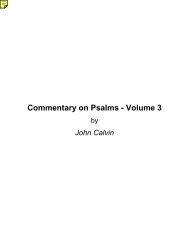The Dolorous Passion of Our Lord Jesus Christ. - documenta ...
The Dolorous Passion of Our Lord Jesus Christ. - documenta ...
The Dolorous Passion of Our Lord Jesus Christ. - documenta ...
You also want an ePaper? Increase the reach of your titles
YUMPU automatically turns print PDFs into web optimized ePapers that Google loves.
<strong>The</strong> <strong>Dolorous</strong> <strong>Passion</strong> <strong>of</strong> <strong>Our</strong> <strong>Lord</strong> <strong>Jesus</strong> <strong>Christ</strong>.Anne Catherine Emmerichthe lives and writings <strong>of</strong> Saints Bridget, Gertrude, Mechtilde, Hildegarde, Catherine <strong>of</strong> Sienna,Catherine <strong>of</strong> Genoa, Catherine <strong>of</strong> Bologna, Colomba da Rieti, Lidwina <strong>of</strong> Schiedam, CatherineVanini, Teresa <strong>of</strong> <strong>Jesus</strong>, Anne <strong>of</strong> St. Bartholomew, Magdalen <strong>of</strong> Pazzi, Mary Villana, Mary Buonomi,Marina d’Escobar, Crescentia de Kaufbeuern, and many other nuns <strong>of</strong> contemplative orders, arealso to be found in the history <strong>of</strong> the interior life <strong>of</strong> Anne Catherine Emmerich. <strong>The</strong> same path wasmarked out for her by God. Did she, like these holy women, attain the end? God alone knows. <strong>Our</strong>part is only to pray that such may have been the case, and we are allowed to hope it. Those amongour readers who are not acquainted with the ecstatic life from the writings <strong>of</strong> those who have livedit, will find information on this subject in the Introduction <strong>of</strong> Goërres to the writings <strong>of</strong> HenrySuso, published at Ratisbonne in 1829.4142Since many pious <strong>Christ</strong>ians, in order to render their life one perpetual act <strong>of</strong> adoration, endeavourto see in their daily employments a symbolical representation <strong>of</strong> some manner <strong>of</strong> honouring God,and <strong>of</strong>fer it to him in union with the merits <strong>of</strong> <strong>Christ</strong>, it cannot appear extra. ordinary that thoseholy souls who pass from an active life to one <strong>of</strong> suffering and contemplation, should sometimessee their spiritual labours under the form <strong>of</strong> those earthly occupations which formerly filled theirdays. <strong>The</strong>n their acts were prayers; now their prayers are acts; but the form remains the same. Itwas thus that Anne Catherine, in her ecstatic life, beheld the series <strong>of</strong> her prayers for the Churchunder the forms <strong>of</strong> parables bearing reference to agriculture, gardening, weaving, sowing, or thecare <strong>of</strong> sheep. All these different occupations were arranged, according to their signification, in thedifferent periods <strong>of</strong> the common as well as the ecclesiastical year, and were pursued under thepatronage and with the assistance <strong>of</strong> the saints <strong>of</strong> each day, the special graces <strong>of</strong> the correspondingfeasts <strong>of</strong> the Church being also applied to them. <strong>The</strong> signification <strong>of</strong> this circle <strong>of</strong> symbols hadreference to all the active part <strong>of</strong> her interior life. One example will help to explain our meaning.When Anne Catherine, while yet a child, was employed in weeding, she besought God to root upthe cockle from the field <strong>of</strong> the Church. If her hands were stung by the nettles, or if she was obligedto do afresh the work <strong>of</strong> idlers, she <strong>of</strong>fered to God her pain and her fatigue, and besought him, inthe name <strong>of</strong> <strong>Jesus</strong> <strong>Christ</strong>, that the pastor <strong>of</strong> souls might not become weary, and that none <strong>of</strong> themmight cease to labour zealously and diligently. Thus her manual labour became a prayer.I will now give a corresponding example <strong>of</strong> her life <strong>of</strong> contemplation and ecstasy. She had been illseveral times, and in a state <strong>of</strong> almost continual ecstasy, during which she <strong>of</strong>ten moaned, and movedher hands like a person employed in weeding. She complained one morning that her hands andarms smarted and itched, and on examination they were found to be covered with blisters, like whatwould have been produced by the stinging <strong>of</strong> nettles. She then begged several persons <strong>of</strong> heracquaintance to join their prayers to hers for a certain intention. <strong>The</strong> next day her hands wereinflamed and painful, as they would have been after hard work; and when asked the cause, shereplied: ‘Ah! I have had so many nettles to root up in the vineyard, because those whose duty itwas to do it only pulled <strong>of</strong>f the stems, and I was obliged to draw the roots with much difficulty out<strong>of</strong> a stony soil.’ <strong>The</strong> person who had asked her the question began to blame these careless workmen,but he felt much confused when she replied: ‘You were one <strong>of</strong> them,—those who only pull <strong>of</strong>f thestems <strong>of</strong> the nettles, and leave the roots in the earth, are persons who pray carelessly.’ It wasafterwards discovered that she had been praying for several dioceses which were shown to herunder the figure <strong>of</strong> vineyards laid waste, and in which labour was needed. <strong>The</strong> real inflammation22



